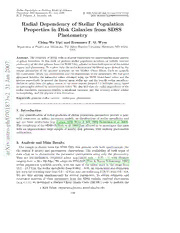
Radial Dependency of Stellar Population Properties in Disk Galaxies from SDSS Photometry PDF
Preview Radial Dependency of Stellar Population Properties in Disk Galaxies from SDSS Photometry
Stellar Populations as Building Blocks of Galaxies Proceedings IAU Symposium No. 241, 2006 (cid:13)c 2006International AstronomicalUnion R. F. Peletier, A. Vazdekis, eds. DOI:00.0000/X000000000000000X Radial Dependency of Stellar Population Properties in Disk Galaxies from SDSS Photometry Ching-Wa Yip† and Rosemary F. G. Wyse Department of Physics and Astronomy,The Johns HopkinsUniversity,Baltimore, MD 21218, USA Abstract.Theevolutionofstellardisksisofgreatimportanceforunderstandingmanyaspects of galaxy formation. In this work we perform stellar population synthesis on radially resolved 7 photometryof564diskgalaxiesfromtheSDSSDR5,selectedtohavebothspectraofthecentral 0 0 regions and photometry.To explore fully themulti-dimensional likelihood space definedby the 2 output parameters of the spectral synthesis, we use Markov Chain Monte Carlo to quantify theexpectation values, theuncertainties and thedegeneracies of theparameters. Wefindgood n agreement between the parameter values obtained using the SDSS broad-band colors and the a J spectra respectively. In general the derived mean stellar age and the best-fit stellar metallicity decline in value from the galaxy center to the outer regions (around 1.5 half-light radii), based 1 on sub-samples defined by concentration index.We also find that the radial dependencyof the 3 stellar population parameters exhibitsasignificant variation, and thisdiversityislikely related 2 to morphology and the physicsof star formation. v Keywords. galaxies: stellar content – techniques: photometric 3 7 8 1 1. Introduction 0 7 The quantificationof radialgradients of stellar population parameters provide a pow- 0 erful constraint on galaxy formation models, as distributions of stellar metallicity and / h age are basic predictions (e.g. Larson 1976, Wyse & Silk 1989, Robertson et al. 2004). p Thecompletionofthe SDSS−I (York et al. 2000)hasallowedustoinvestigatethisissue - o with an unprecedented large sample of nearby disk galaxies, with uniform photometric r calibrations. t s a : v 2. Analysis and Main Results i X Our sample is chosen from the SDSS DR5 disk galaxies with both spectroscopic (for the central 3 arcsec) and photometric observations. The availability of both types of r a data allow us to characterize the parameter uncertainties using only the photometry. They are low-inclination (isophotal minor axis/major axis = 0.25− 1) with distance rangingfrom∼20−700Mpc.We adoptthePE´GASE(Fioc & Rocca-Volmerange 1997) stellar population synthesis models, with the ages of the oldest stars in the range from 12.5−13.7Gyr,the stellarmetallicity from0.0001−0.05,anexponentialstar-formation law withthe e-folding time from0.2−12Gyr,andthe reddening E(B-V)from0.0−0.8. We are thus solving simultaneously for several parameters. To obtain estimates and covariance matrices of these parameters from the SDSS radially resolved photometry (u,g,r,i,z), we developed a Markov Chain Monte Carlo (MCMC) code to perform the † Keck Fellow; [email protected];[email protected]. 119 120 C. W. Yip and R. F. G. Wyse minimization in N-dimension. Each annulus of each galaxy is treated independently in the minimization. Figure 1. Radial dependency of stellar metallic- Figure 2. Radial dependencyof themean ity, averaged in three ranges of concentration in- stellar age. dex (CI): 0.15−0.40 (rhombus), 0.40−0.45 (tri- angle) and 0.45−0.65 (square). The smaller the CI, themore concentrated is the galaxy light. The stellar metallicity and hagei as a function of radius (r/r , where r is the eff eff half-light radius of the galaxy) are shown in Fig. 1 and 2 respectively. The error bar indicates one sigma of the mean value in each axis. Radial dependencies are found for these two parameters, in that they decrease toward larger radii (cf. similar results for 121 disk galaxies, from a combination of broad-band optical and near IR data from Bell & de Jong 2000).Inaddition,wefindaclearseparationbetweengalaxiesofdifferent r−bandconcentrationindices(CI’s)):the moreconcentratedarethe galaxies,the higher the values in the stellar metallicity and hagei. While the overall trends are compatible with ‘inside-out’ models of disk galaxy formation, there are interesting systematics in the gradients shown in the figures. Further, we see features in individual galaxies at intermediateradiithatcouldbeamanifestationofresonancesassociatedwithbarsandwe areembarkingonamoredetailedmorphologicalcharacterizationofthegalaxiese.g.bulge to disk ratio, barred nature etc. In particular, some models predict that bars could lead to a localized old age within r/r ∼ 0.7 (V. Debattista, private communication). The eff details of our analysis and results will be presented in a separate paper. We acknowledge support from the W. M. Keck Foundation, through a grant given to establish a program of data intensive science at JHU. References Bell, E.F. & deJong, R.S. 2000, MNRAS 312, 497 Fioc M. and Rocca-Volmerange B. 1997, A&A,326, 950 Larson R. B. 1976, MNRAS,176, 31 Robertson B., Yoshida N., SpringelV. and Hernquist L. 2004, ApJ, 606, 32 WyseR. F. G. & Silk J. 1989, ApJ, 339, 700 York D.G., Adelman J., Anderson J. E. et al. 2000, AJ, 120, 1579
